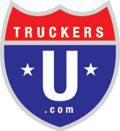How much does that load pay? This is the worst question you can ask when talking to a freight broker or shipper. Why? Because it puts total control of what they’ll pay on the load into their hands.
What’s an easier way?
You have a wheelbarrow filled with dirt at the top of a hill, or you have the same wheelbarrow at the bottom of a hill. Obviously getting that dirt-filled wheelbarrow to the bottom of a hill would be a lot less work than trying to push it to the top. Now think of this wheelbarrow as your freight rate: do you want it at the top of the hill, or in the ravine at the bottom? If you ask, “How much does the load pay?” you’ve just put your rate wheelbarrow at the bottom of the ravine. If you don’t ask the question, it’s on the top of the hill. All you need to do is control your descent.

How to keep from lowering your rates
To keep your rates from dropping too far down the hill, you need to know:
- How many days does the load require?
- How many actual miles will be traveled from destination to destination? (from where your last load was completed to the final delivery point of this load)
- Space and weight the load requires?
- Truck-to-freight ratios affecting available load rates
- The current cost of fuel per mile for the trip
- Current operational cost per mile
- Additional costs like tolls, labor, permits, etc.
- Your current daily fixed cost
Once you have this information, you’re ready to work toward keeping your rate wheelbarrow as near the top of the hill as possible. The point: it’s much more difficult to move a hauling rate higher than it is to lower one. But if you allow the shipper or broker to quote you a low rate or you fail to have the correct data concerning the rates and other freight in the area, you have created the task of needing to push your rate higher. Know the market forces which can affect your rate and have the information at hand to be sure you receive the best rate.
Best negotiation tactics:
- Never ask how much the load pays.
- Verify your load information is correct.
- Have a negotiation strategy.
- Know the absolute rate you must have, and never move from it. This must not be less than the lowest end of your Hauling Rate Range.
- Know the truck-to-freight ratios for the area you’ll be hauling from and the destination where the load is to be delivered.
- Know the spot freight rate range for the area and the type of freight you’re considering.
- Quote a hauling rate which is within your hauling rate range and takes into consideration the origin truck-to-load ratio, the current spot freight rate range and what the load rate potential of where the load is going.
If they accept your rate, you’re home free;
If they balk, negotiate.
- Be able to support your quote with the data mentioned above. Justify your rate by knowing the market.
- Never give something away without getting something of equal or greater value in return.
- If they ask you to give up something, make it seem like it’s painful.
- At all times, have your break-even figures, your hauling rate range, and data in front of you.
- Anticipate the unexpected. Know your worst-case scenario.
- Be prepared to sell service – not price.
- Be ready to say ‘no’, but always leave a way for them to contact you in case they change their mind.
- Always be polite and courteous. You might need them again.
- If the broker quotes an unacceptable rate, break off the conversation temporarily. You regain control when you call back.
- Negotiating hauling rates works like gravity—it’s easy to lower a rate; next to impossible to raise one.
In other words, keep your freight rate-filled wheelbarrow under control and as close to the top of the hill as possible, and you’ll receive the revenue you need to make a profit

